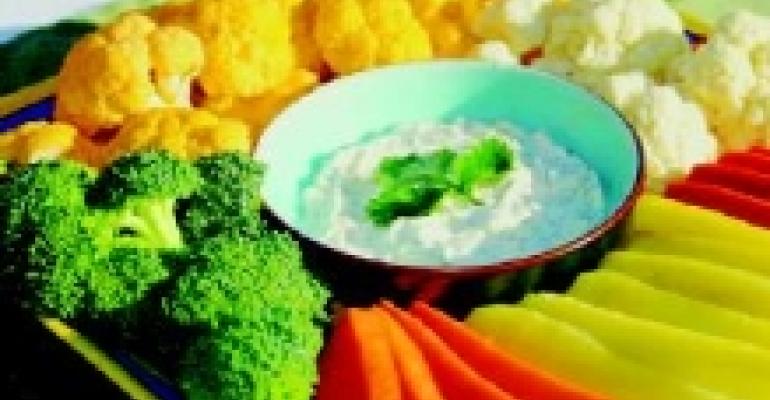Jody Shee
 |
| COLORFUL IDEAS: Specialties such as orange cauliflower dress up your vegetable menu. |
 |
| SEEING RED: When this red corn is grilled, it turns a memorable dark scarlet. |
It's one of those amazing marvels of nature. The most colorful fruits and vegetables you can dish up to guests happen to house the most nutrients. But that can be your little secret.
Advance the cause of nutritious restaurant food by experimenting with rich, vibrant, colorful vegetables. Who wouldn't love that?
Instead of basic potato salad, consider a special featuring purple Peruvian potato salad. The potato's deep purple skin and flesh add drama. The color diminishes the longer you cook the potato, so blanch it with vinegar water to lock in the color. To their advantage, purple potatoes take less time to cook.
The creamy flavor and texture of purple potatoes and their growing popularity in the U.S. have led some to use them for mashed potatoes. And consider the breakfast plate. Purple potato hash browns add some tint to an otherwise pale presentation. For lunch, serve up some of your own baked purple potato chips.
For something earthy yet sweet, discover the power of beets, which come in red, purple, white, gold and striped. They have the highest sugar content of all vegetables and make a great substitute for baked potatoes. Simply wrap them in foil with honey, butter, salt and pepper and bake them. Poke a hole in them to release the steam. For another baked application, let them cool, remove the skin and toss the colorful beets into a salad with goat cheese, which adds tartness.
Peel beets after you cook them to retain the most color. If you boil beets, keep them whole and add an acidic like lemon juice while cooking to brighten the color. Only add salt at the end.
If you don't want the beet peel to go to waste, dehydrate the trimmings to make beet powder and sprinkle atop flat bread for amazing color and flavor.
Through the wonders of natural plant breeding, you can even find unusual colors among common vegetables.
For example, grower-shipper Colorful Harvest LLC, Monterey, CA sells Scarlet red sweet corn and yellow heirloom golden sweet carrots. Both have great flavor as attested by the gold medals they received at the recent Masters of Taste Awards sponsored by the Chefs in America Award Foundation.
Within the past few months, Colorful Harvest introduced supersweet Scarlet-brand red corn, which is sweeter than its regular red corn with a longer shelf life (15 to 20 days). When you grill the red corn, it turns a dark scarlet color. If you boil or steam it, the corn turns purplish red. Recent research shows that the red sweet corn has 350 percent more antioxidants than white or yellow corn.
The company is experimenting with blue corn and hopes to have it available in the next few years.
Golden sweet carrots are shorter and stockier than regular carrots, but they are sweet and juicy with a unique crunch. If you cut them into sticks, they almost look like french fries. Shred them or make them into matchsticks and sprinkle them on a salad for color. Or, cut them into long, thick sticks and blend them with green beans. Imagine offering a side of orange cauliflower, which is becoming more widely available. The orange pigment, as you might guess, comes from betacarotene. Cook it, steam it or mix it with other ingredients. Orange cauliflower makes a great centerpiece for a vegetable tray if you hollow a head and fill it with vegetable dip.
Rainbow of NutrientsDiscover the gold mine of vitamins and phytochemicals contained in the rainbow of colorful fruits and vegetables. To learn which fruits and vegetables contain these nutrients, visit www.5aday.gov/color Green: Lutein, Zeaxanthin, Indoles, Vitamin K, Potassium Yellow/Orange: Beta-Carotene, Vitamin A, Bioflavonoids, Vitamin C, Potassium Red: Vitamin C, Anthocyanins Blue/Purple: Anthocyanins, Vitamin C, Phenolics White: Allium and Allicin Source: National Cancer Institute |
PHOTOGRAPHY: COLORFUL HARVEST LLC





